Large, predatory birds known as “tiger owls” or “hoot owls” can be found throughout the United States and Canada. They are some of the most widely distributed owls in the world, and they come in a wide range of colors and patterns. One of the only owls employed in falconry, they are a stunning sight.
Size and shape
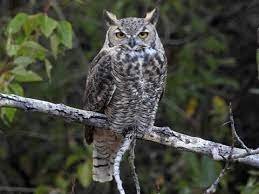
It has two noticeable tufts of feathers on the head, which are big, thick-bodied, and elongated. Wings that are wide and rounded are seen. The rounded head and small bill make a blunt-headed silhouette when flying. They can reach heights of over two feet and weigh as much as three pounds in the wild, on average (in females). They can get as heavy as 5.5 pounds in some subspecies. The wingspan of a great horned owl is approximately 4.6 feet. As long as 3 inches, their talons can exert up to 300 pounds of power per square inch. It’s safe to say that owls are formidable predators.
Identification of the Great Horned Owl
Despite its massive size, the great horned Owl is well-known for its ability to blend in with its surroundings. Despite the fact that great-horned owls in various areas can be of different colors, birders can correctly identify this owl by recognizing its important traits and field marks. The huge ear tufts, even though they aren’t ears at all, are an easy way for birders to identify this variety of owls. However, these tufts are not unique to great-horned owls, and other owls have them as well.
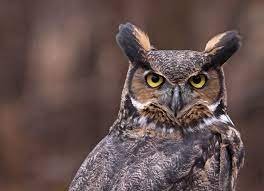
Female great-horned owls are larger than their male counterparts, but the sexes are nearly identical. There is fine brownish-gray mottling on the upper parts, as well as checkered barring on the wings, and horizontal banding on the lighter underparts. Gray to orange-rust in color, the face disc is framed by a narrow black border. Toward the chin and the throat, white extends from the bill. The eyes are a bright yellow color with black pupils.
In their first year of life, juvenile great-horned owls appear to be fluffy grey-white balls with short triangular ears and enormous eyes. As they mature, however, the feathers and colors on the wings and facial disc begin to take on a more unique appearance. It will be a matter of weeks before the fledgling birds resemble their parents.
How big is the wing span of the largest owl?

Central and South America’s Great Horned Owls may be the largest, but their wingspan is not the largest in North America. The snowy owl is the clear winner here. Even though they can grow up to 5 feet long, snowy owls can weigh as much as 4.5 pounds. Beautiful owls are recognized for their white plumage that perfectly suits their snowy habitats. They are found mostly in the far north of Canada, up into the tundra.
No owl is bigger in North America than the snowy owl, but it isn’t. The Blakiston fish owl is the world’s largest owl. Having a wingspan of six feet and a maximum weight of 8.8 pounds, the Blakiston fish owl is no small bird. In the wild, just 1,500-3,700 owls survive. They are extremely rare. They can be found in China, Japan, and parts of eastern Russia. They may get that big because they only eat fish, primarily salmon.
Color Patterns
Brownish-red heads and a white throat patch distinguish Great Horned Owls. Their overall colour might range from sooty to pale, depending on the location.
Behavior
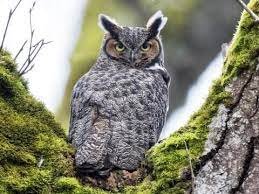
These owls are nocturnal creatures. Their rounded wings can be seen at dusk perched on fence posts or tree limbs in open places, or flying across highways or fields with stiff, deep beats. Four to five hoots are all it takes for them to make their distinctive call.
Also, know A good name for an owl
How fast can an owl fly?
Great horned owls can fly at rates of up to 40 miles per hour on average. For non-fleeing or hunting purposes they tend to maintain a pace of roughly 25mph. These owls are among the fastest fliers in the owl family because of this. Owls don’t need to be as swift as hawks or eagles to grab their prey since they rely on stealth rather than speed. The great horned owl has been measured at 40 mph, making it the fastest owl in the world.
More facts on the great horned owl
Owls are some of nature’s top predators. They have some of the largest proportionate eyes of any terrestrial vertebrates on the planet, which is a fascinating fact. This helps them to see even the tiniest of movements, even while hunting at night. They also have asymmetric ears. Hearing prey that isn’t in sight is made easier by this asymmetry, which improves sound triangulation. The different-sized ear holes aid in determining distance and direction better than two identically sized ears. In the snow or under leaf cover, this adaption is particularly useful for hunting rodents and small mammals. There’s no way for an owl to move its eyes, so it moves its entire head. When on the prowl for prey, a great horned owl can turn its head a full 270 degrees.
The Habitat and Range of the Great Horned Owl
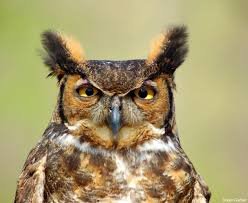
They can be found in different kinds of environments, from the open desert to dense forests, marshy marshes, and solitary tundra, depending on the availability of prey. It is possible to find these birds year-round in North and South America, with the exception of the most extreme Arctic regions. However, they are rarely observed in the deepest tropical jungles.
Migrating Methods
Great horned owls do not consistently migrate, even in the winter months, when prey is more limited.
Feeding and Nutrition
When it comes to their prey, these owls have an impressive array of options. They’ll eat anything from tiny animals to birds to reptiles and amphibians. If they’re aggressive hunters, they may even target other raptors, such as ospreys and peregrine falcons, as well as their young. Great horned owls are carnivorous, like are all other raptors. To catch prey, these owls sit on high branches, listening and watching intently.
Nesting
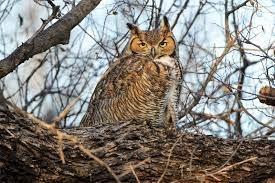
When it comes to owls, there is no better time than the winter to start your nesting season than January or February. Stick nests are favored over those built by other raptors, and this is the most common type of nest they employ.
The white, spherical eggs are incubated for 30-35 days by the female parent, and the infant owlets are cared for by both parents for an additional 35-45 days. A single brood, usually containing 1-5 eggs, is reared only once a year.





